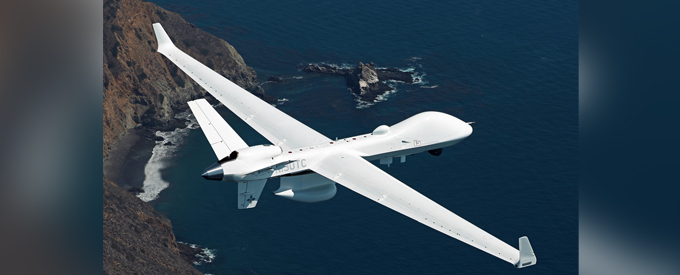2020-12-13
GA-ASI Starts SeaGuardian Validation Flights in Japan
General Atomics Aeronautical Systems, Inc. (GA-ASI), a leader in Remotely Piloted Aircraft Systems (RPAS), recently kicked off a series of validation flights for Japan Coast Guard (JCG) in Hachinohe, Aomori Prefecture. The company is working with Asia Air Survey (AAS) in Japan to conduct the flights.
The flights will validate the wide-area maritime surveillance capabilities of RPAS for carrying out JCG’s missions, from search and rescue to maritime law enforcement. These flights follow successful “legacy” MQ-9 maritime patrol demonstrations in the Korea Strait in 2018 and the Aegean Sea in 2019. The Hachinohe operation features the MQ-9B configuration, capable of all-weather operations in civil national and international airspace.
The SeaGuardian RPAS features a multi-mode maritime surface-search radar with Inverse Synthetic Aperture Radar (ISAR) imaging mode, an Automatic Identification System (AIS) receiver, a High-Definition - Full-Motion Video sensor equipped with optical and infrared cameras. This sensor suite, augmented by automatic track correlation and anomaly-detection algorithms, enables real-time detection and identification of surface vessels over thousands of square nautical miles.
High Performance Radars
GA-ASI’s radar system development has set a high standard for detection systems for RPA, including the Lynx Multi-mode Radar and the Due Regard/Air-to-Air Radar.
Lynx Multi-Mode Radar: GA-ASI’s Lynx Multi-Mode Radar is a high-performance system that provides high-resolution, photographic-quality imagery that can be captured through clouds, rain, dust, smoke and fog. Designed to meet the onboard challenges of the RPAS environment, the Lynx radar consumes minimal Size, Weight, and Power (SWAP) while delivering precision air-to-surface targeting accuracy and wide-area search capabilities for both ground and maritime missions.
Lynx features its Synthetic Aperture Radar (SAR), Ground/Dismount Moving Target Indicator (GMTI/DMTI), and robust Maritime Wide Area Search (MWAS) modes. Its search modes provide wide-area coverage for any integrated sensor suite, allowing for cross-cue to a narrow Field-of-View (FOV) Electro-optical/Infrared (EO/IR) sensor. The radar continues to be deployed on RPA and manned aircraft throughout the world.
Synthetic Aperture Radar: Lynx includes two spotlight and two stripmap SAR modes. Spotlight mode produces high-resolution imagery on a defined point. Stripmap mode mosaics multiple spot SAR images together to form one large image. Using SAR imagery, subtle changes in the scene are detected by overlaying two images taken at different times. Amplitude Change Detection (ACD), and Automated Man Made Object Detection (AMMOD) algorithms highlight the differences between the first and second SAR image, providing an effective imagery analysis tool.
Ground/Dismount Moving Target Indicator: The GMTI mode provides an easy method for locating moving vehicles. While the GMTI mode continues to be a crucial resource, DMTI marks a real paradigm shift. DMTI allows operators to detect very slow-moving vehicles and personnel (dismounts) moving at about 1 mph. Integrated into USAF MQ-9 Reaper RPA, the DMTI mode allows operators to detect slow-moving, operationally significant personnel or vehicles.
Maritime Wide Area Search: Lynx’s MWAS mode detects ship and boat traffic in various sea state conditions; it also integrates AIS information for target correlation and identification. MWAS excels in missions such as coastal surveillance, drug interdiction, long-range surveillance, small target detection, and search and rescue operations. In the summer of 2014, MWAS was demonstrated for the U.S. Navy during Experiment Trident Warrior where it successfully executed numerous littoral missions, demonstrating its ability to detect surface vessels in various weather conditions and cross-cue to EO/IR sensors for target classification and identification.
Due Regard Radar in Development
The Due Regard Radar (DRR) is an air-to-air radar being developed under company funding to meet the requirements envisioned to enable RPA to fly in International Airspace. The DRR is comprised of a two panel Active Electronically Scanned Array (AESA) Antenna and a Radar Electronics Assembly (REA) that give the RPA pilot the ability to detect and track aircraft across the same Field-of-View (FOV) as a manned aircraft. AESA technology allows DRR to track multiple targets while simultaneously continuing to scan for new aircraft. Flight tests of a pre-production DRR are underway on both a manned aircraft and a Predator B RPA.
DRR is a key component of GA-ASI’s overall airborne Detect and Avoid (DAA) architecture for Predator B. The DAA system must detect and avoid cooperative (i.e., aircraft equipped with a transponder) and non-cooperative (i.e., aircraft not equipped with a transponder) aircraft. Detection and tracking of cooperative aircraft are performed by the Traffic Collision Avoidance System (TCAS) and Automatic Dependent Surveillance-Broadcast (ADS-B).


No Comments